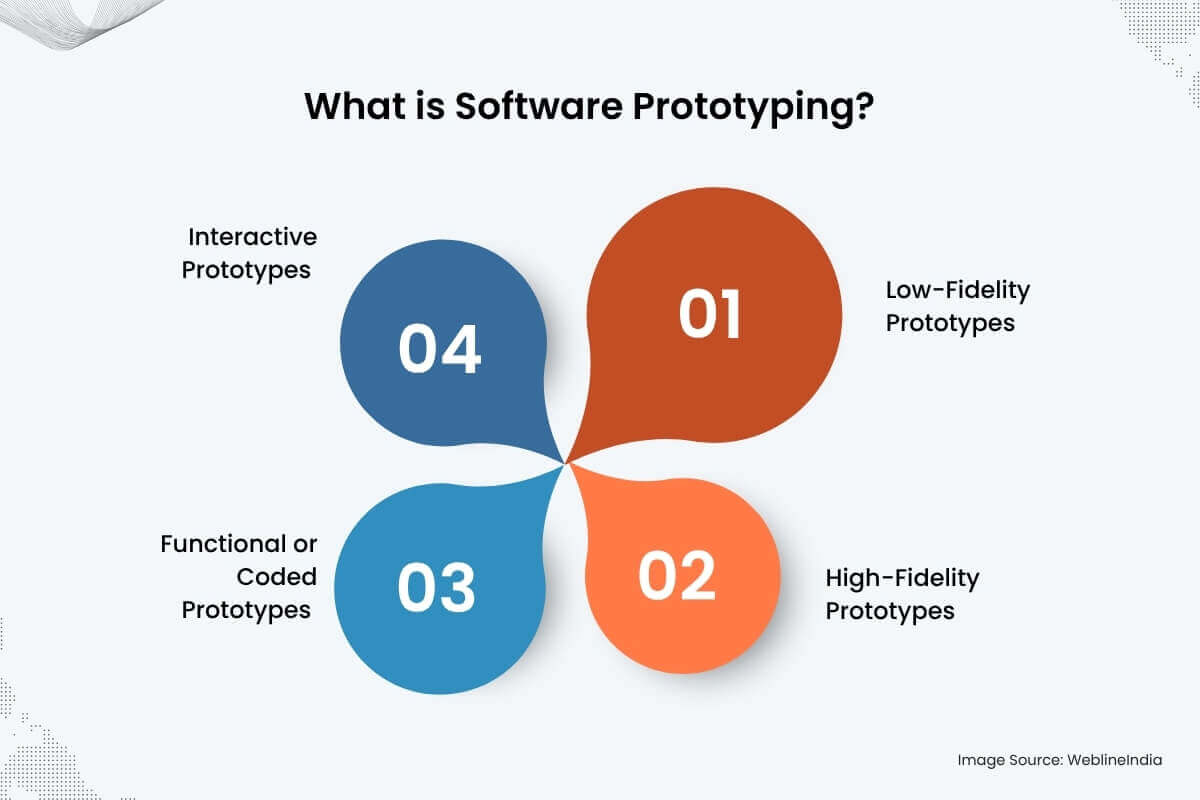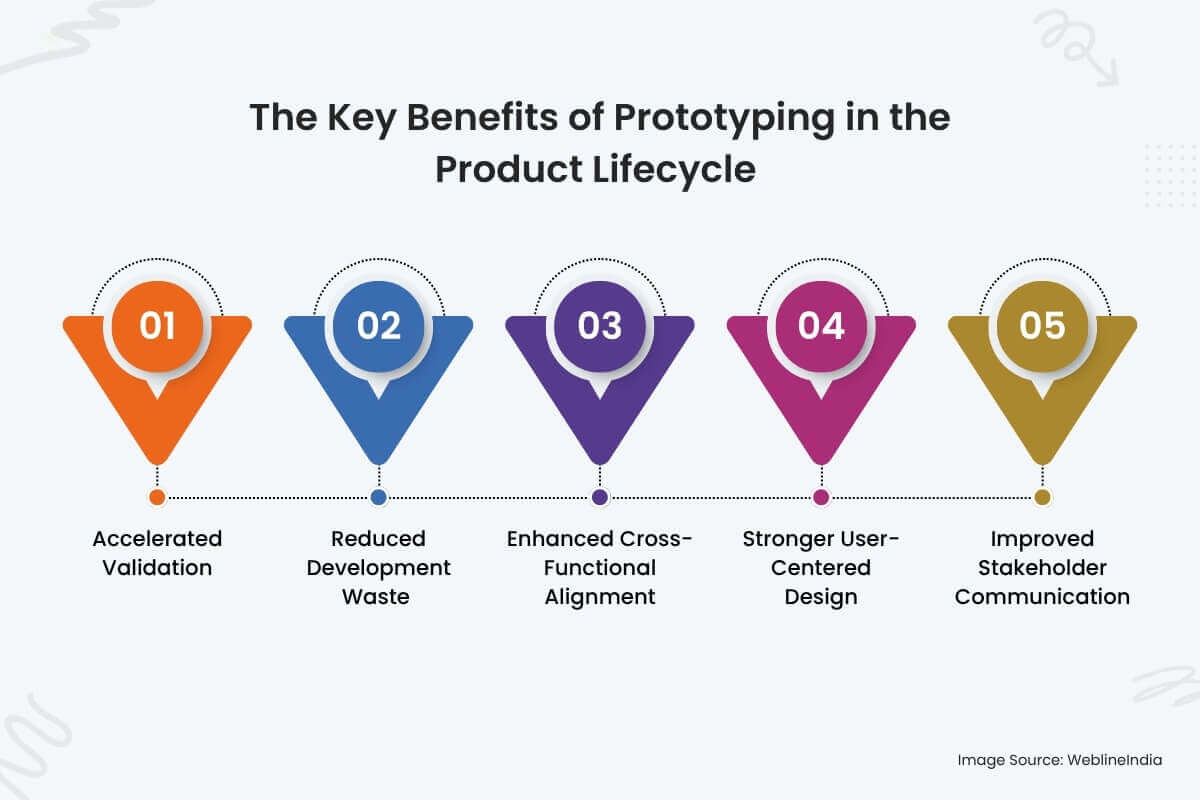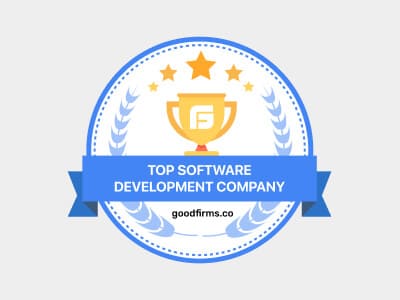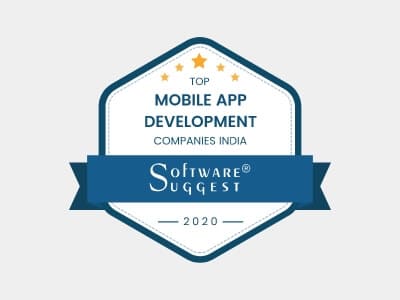Every groundbreaking product starts as a simple idea. But ideas, by themselves, are fragile. They’re abstract, intangible, and often misunderstood when left inside someone’s head or scribbled in a notebook. The real transformation begins when that idea is shaped into something others can see, test, and experience — in other words, a software prototype or application prototype.
Today, we witness a fast-moving innovation ecosystem, and the ability to move quickly from idea to execution is critical. This is where the question what is prototyping becomes highly relevant. Software prototyping is more than just sketching screens or mocking up interfaces — it is a structured way to visualize and validate your vision using modern prototyping tools that make early testing possible.
This blog will take you through what is software or mobile app prototyping, why it matters, and how it fits into your journey from idea to MVP. You’ll learn about the benefits of prototyping, the best prototyping tools available today, and how emerging technologies like LLMs and vibe coding are reshaping the way we create.
Curious how your idea would look and feel before writing a single line of code?
We’ll also share WeblineIndia’s exclusive 2-hour free live software prototyping offer to help you get started with your own MVP.
What is Software Prototyping?
If you’ve ever wondered what is prototyping, the simplest answer is this: it’s the act of turning an idea into a tangible, testable version of a product. A prototype is not the final product — it’s a temporary representation used to explore, test, and improve. Whether you’re building a software prototype for a SaaS platform or an application prototype for a mobile app, prototyping helps you validate ideas before investing in full development.
There are many types of software prototypes, each with a distinct purpose depending on the stage of your product journey:

Low-Fidelity Prototypes
These are fast, sketch-level representations that help define layout and flow. They can be created using pen and paper or basic prototyping tools, allowing for quick iteration and feedback for your software tool.
High-Fidelity Prototypes
These resemble the finished product in both design and functionality. A high-fidelity application prototype often includes real UI elements, navigation, and user interactions in a mobile app or software tool. It’s ideal for usability testing and pitching to investors.
Functional or Coded Prototypes
These simulate actual product behavior using limited or simplified code. They provide insight into how the software prototype would perform in real-world conditions.
Interactive Prototypes
These enable users to click, swipe, or type, mimicking actual use. Built with advanced software prototyping tools, they allow teams to test flows and user experience with minimal effort.
The core benefits of prototyping lie in learning quickly. It’s not about building the perfect solution — it’s about making something good enough to test, improve, or even discard based on real feedback. This reduces guesswork and eliminates waste. Modern software prototyping tools have made this process faster and more collaborative. Tools like Figma, Webflow, and Lovable Bolt v0 let you create interactive models in hours. You can go from a raw idea to a clickable application prototype without writing a line of code.
In summary, understanding what is software prototyping gives you a competitive advantage. It empowers you to:
- Test assumptions early
- Visualize workflows clearly
- Communicate ideas effectively
- Reduce risk and cost
- Move closer to your MVP with confidence
Every software product team should view mobile app prototyping not as a step, but as a mindset — a continuous practice that transforms vague concepts into validated directions.
How Software Prototyping Helps Visualize Your Idea?
Ideas are only as good as your ability to express them. You can describe a software product concept in words or pitch it with slides, but until people can actually see or interact with it, understanding remains limited. This is where a software prototype or application prototype becomes a game changer. It turns abstract thinking into a clear, functional representation that others can grasp instantly.
Understanding what is prototyping helps explain why visualization is so important. A software prototype serves as a working model that shows how your product will look and behave. Whether it is a simple wireframe or a clickable interface, it transforms assumptions into something visible and interactive. This not only clarifies your own thinking but makes it far easier to share and refine your idea with others.
Software or mobile app prototypes make feedback more meaningful. When users or stakeholders can engage with a live interface, they provide much more relevant insights. A well-designed application prototype eliminates guesswork by simulating how someone would actually use the product. This helps you discover what works, what confuses users, and what features need improvement.
One of the major benefits of software prototyping is alignment. With a shared visual and functional reference, your team can collaborate more effectively. Designers, developers, marketers, and decision-makers can all speak the same language by pointing to elements inside the software prototype instead of interpreting vague descriptions.
Creating a mobile app prototype also allows you to test user flows before building them. This saves time and money, and it ensures that the most important product interactions are validated early. Instead of debating whether a feature is necessary, you can prototype it quickly using modern prototyping tools, then test it with users to see if it adds value.
When you put your idea into a software prototype, you’re not just building a model — you’re building clarity. You remove ambiguity, validate direction, and accelerate momentum. Visualization is more than aesthetics. It is progress.
In the end, a prototype is the first version of your mobile app or software tool that people can understand, touch, and respond to. That makes it one of the most essential tools for turning a concept into reality.
Why Software Prototyping is Crucial in the Mobile App Development Process?
In today’s fast-paced digital landscape, teams cannot afford to wait until full development to test ideas. Understanding what mobile app prototyping is and why it matters can save you months of wasted time and thousands in sunk costs. Whether you are designing a software prototype or an mobile application prototype, the earlier you start testing, the better your results will be.
Software Prototyping is critical because it provides structure to uncertainty. Instead of relying on opinions or intuition, you gather real feedback from real users. This turns software product development into a learning process instead of a guessing game.
Validate your app flow, design, and core features — before you start full-scale development.
The Key Benefits of Prototyping in the Software Product Development Lifecycle
The benefits of prototyping go beyond visualization. It accelerates alignment within teams, improves communication with stakeholders, and reduces the risk of building something people don’t want. Whether you’re preparing for an MVP launch, raising funds, or just clarifying your thinking, creating a software prototype helps you move forward with confidence.

Accelerated Validation
Software prototyping allows teams to test assumptions quickly. Within days, you can create a software prototype using modern prototyping tools and validate the core value proposition before building anything in production.
Reduced Development Waste
Early prototypes highlight what works and what doesn’t. This ensures your development team only spends time building features that have already been validated by user feedback.
Enhanced Cross-Functional Alignment
An interactive application prototype becomes a common language across teams. Designers, developers, and stakeholders align faster because they are all referencing the same working model.
Stronger User-Centered Design
You gain insights into how real people will interact with your product by involving users in early testing. This helps prioritize user experience, leading to higher engagement and satisfaction post-launch.
Improved Stakeholder Communication
Explaining an idea is one thing but showing it through a software prototype makes it tangible. Investors, clients, or internal sponsors can engage with the product and offer actionable feedback.
The Role of Software Prototyping Tools
Modern prototyping tools like Figma, Framer, and Lovable Bolt v0 empower teams to move fast. You no longer need to wait for a developer to bring your vision to life. These tools allow for drag-and-drop interactivity, real-time collaboration, and rapid iteration — all of which reduce friction and increase speed.
Prototyping is not just a design phase — it is an ongoing process of learning, adjusting, and validating. Teams that embrace prototyping early and often are better equipped to deliver high-impact MVPs with less waste and more focus.
Prototyping and Its Role in Reaching the MVP
Every successful product launch begins with a clear path to a Minimum Viable Product (MVP). The MVP is your product’s simplest form that still delivers value to users — a version that allows you to validate assumptions and learn from real usage without the cost of full-scale development. A well-built software prototype or application prototype is often the fastest route to get there.
When asking what mobile app prototyping in the context of MVP development is, the answer lies in its ability to evolve your raw idea into something structured and testable. Instead of waiting until everything is built, you create interactive models that simulate your product’s behavior. These early versions help answer critical questions: Does the core feature solve the user’s problem? Is the flow intuitive? Will people pay for this?
Using software development prototyping tools, you can simulate the user experience, test functionality, and even mimic data interactions. This enables your team to validate the most important assumptions tied to your MVP — without writing production code. As you iterate on your software prototype, each version gets you closer to something you can release, measure, and improve.
One of the key benefits of software prototyping in the MVP process is cost efficiency. Instead of investing heavily in building features that may not matter, you validate what users truly need. You also reduce technical debt by confirming functionality before development begins, saving time and resources in the long run.
Consider this workflow:
- Start with a low-fidelity application prototype to sketch basic layouts and flows
- Turn it into a high-fidelity software prototype using interactive design tools
- Test the prototype with real users or internal stakeholders
- Gather feedback, iterate, and gradually refine it toward an MVP
- Launch the MVP with confidence, backed by validated design decisions
This iterative approach isn’t just smart — it’s fast. By building and testing quickly with prototyping tools, you make progress visible to your team and stakeholders. You also create a direct feedback loop that ensures you’re building the right thing.
Ultimately, prototyping bridges the gap between concept and execution. It turns the abstract into the actionable. And it gives startups, product teams, and innovators a clear, visual path toward MVP without the overhead of a fully built product.
Modern Software Prototyping Tools and Technologies
The tools we use to prototype today are more powerful, accessible, and intelligent than ever before. You no longer need to be a seasoned developer or designer to create a high-quality software prototype or application prototype. With the rise of no-code platforms, real-time collaboration suites, and AI-assisted interfaces, the world of prototyping tools has expanded dramatically.
Understanding what is prototyping today means understanding the ecosystems that power it. Modern tools go beyond simple wireframing. They allow full interaction design, team collaboration, logic simulation, and even backend connectivity — all before a single line of production code is written.
Popular Prototyping Tools for Software and Application Development
With the rapid rise of collaborative design platforms, AI-assisted coding, and no-code development, the process of building a software prototype has become faster and more accessible than ever. Now, anyone can go from concept to clickable application prototype in a matter of hours, not weeks. Here are some of the top prototyping tools for software and application development:
Figma
Figma is a collaborative interface design tool that lets you build high-fidelity, interactive designs right in the browser. It supports plugins, shared libraries, and team collaboration, making it ideal for UI-focused software prototype creation.
Framer
Framer offers a design-to-code experience that blends visual design with advanced animations and logic. It’s especially useful for building highly dynamic application prototypes that simulate real user interactions and transitions across complex flows.
Webflow
Webflow allows you to design, build, and launch websites visually, while still producing clean, exportable code. It’s a top choice for startups validating landing pages or early-stage MVPs through high-fidelity software prototypes.
Bravo Studio
Bravo bridges Figma with real backend data, allowing non-technical teams to turn static designs into functional mobile apps. It’s ideal for turning mockups into fully testable application prototypes without writing code.
Lovable Bolt v0
Bolt v0 is a new entrant designed for rapid ideation and playful prototyping. Focused on creativity and collaboration, it combines intuitive UI tools with real-time feedback — perfect for teams that want fast, flexible software prototypes with minimal friction.
Penpot
An open-source alternative to Figma, Penpot is especially useful for teams that want full control over their design environment. It supports team collaboration, reusable components, and seamless handoff to developers.
ProtoPie
This tool enables designers to create realistic, device-level interactions and motion prototypes. If your application prototype requires detailed animations and advanced sensor inputs, ProtoPie is worth exploring.
Glide
Glide turns spreadsheets into mobile apps. It’s one of the simplest ways to build a working MVP using structured data, great for quick validation without heavy tech lift.
Choosing the Right Software Prototyping Tool
Every project is different, so your choice of prototyping tools should depend on what you’re trying to validate:
- For quick UX exploration and low-fidelity designs, Figma or Penpot will serve well.
- For high-fidelity, animated software prototypes, Framer or ProtoPie offer more depth.
- For full-on MVP experiments without code, Glide or Webflow can bridge the gap to live testing.
- For early creative collaboration or team workshops, Lovable Bolt v0 adds an expressive, flexible layer.
These tools reduce the time between idea and execution, enabling you to test your application prototype with users, teammates, or investors — often in a single day. The benefits of prototyping with the right platform include shorter timelines, better team alignment, and fewer costly surprises during development.
The Power of Vibe Coding, LLMs, and MCP in Mobile App Prototyping
As technology continues to evolve, so do the ways we build, test, and iterate on digital products. New paradigms like vibe coding, the rise of LLM (Large Language Model) integrations, and MCP (Model-Centric Prototyping) are changing the very meaning of what is prototyping. These innovations dramatically accelerate how we build a software prototype or application prototype, and help teams move from concept to MVP faster than ever before.
These aren’t just buzzwords. They are real, emerging approaches that offer immense value when integrated with modern prototyping tools.
Vibe Coding: Collaboration Meets Creativity
Vibe coding introduces a real-time, collaborative way of building products where developers and designers work together in a shared environment. It’s about designing with code and coding with design in mind — closing the gap between logic and visuals.
Collaborative synergy in real time
Vibe coding allows team members to co-build an application prototype without switching tools or contexts. Everyone stays in the same creative zone, which improves productivity and clarity from the start.
Instant testing and refinement
You can test visual and functional components instantly. This improves iteration cycles and supports rapid validation — one of the top benefits of prototyping in lean product development.
LLMs: AI-Powered Prototyping Assistance
The integration of LLMs (like GPT-4) into design and development tools is changing the role of prototyping altogether. These models can generate copy, suggest UI elements, or even build code snippets for your software prototype on the fly.
Design with natural language prompts
Teams can use simple text instructions to generate buttons, layouts, and workflows — dramatically lowering the barrier to entry for non-technical founders and product managers.
AI-assisted prototyping tools
Several prototyping tools now include AI-powered features to auto-fill, design, or connect flows. This makes it possible to build high-quality application prototypes with a fraction of the effort.
MCP: Model-Centric Prototyping
MCP (Model-Centric Prototyping) puts structured logic at the center of the prototype. Instead of focusing only on visuals, it models relationships, data flows, and logic up front. This makes it easier to scale prototypes into MVPs later.
Smart structure for serious testing
MCP ensures that your software prototype has a strong foundation in logic and interaction. It helps teams identify dependencies and constraints early, reducing rework during development.
Faster transition to MVP
With MCP, once the prototype is validated, it can often be converted into real code much more easily. This shortens the gap between testing and launching a functional MVP.
Why These Trends Matter
Vibe coding, LLMs, and MCP are not just enhancements — they are shifts in how teams build. By combining creative ideation with intelligent systems, teams can produce more effective application prototypes in less time and with better accuracy. When paired with traditional prototyping tools, these innovations offer a powerful, forward-looking workflow for modern product teams.
If you are still relying on basic wireframes or static screens, it’s time to rethink your approach. These new technologies represent the next generation of rapid iteration and intelligent design — making the benefits of prototyping even more impactful than before.
Our Free 2-Hour Live Software Prototyping Offer
You’ve explored what it takes to move from idea to MVP. You now understand what is prototyping, the core benefits of prototyping, the tools involved, and how emerging tech like LLMs and vibe coding can supercharge your process. But theory only gets you so far. Real progress comes from building.
That’s why WeblineIndia is offering something practical — and completely free.
We’re inviting startups, founders, product leads, and creative teams to book a free 2-hour live mobile app prototyping and/or software prototyping session with our experts. In this session, we’ll take your raw idea or rough sketch and turn it into a working software prototype or application prototype using cutting-edge prototyping tools.
This is not a webinar. It’s a hands-on, high value working session designed to help you leave with something real.
What You’ll Get During the Session
Live Collaboration with Product Experts
Our in-house software prototyping team will work side-by-side with you (virtually) to understand your idea, your goals, and your users. We’ll use live tools to build and refine your application prototype in real time.
Interactive Prototype Delivered by the End
You’ll walk away with a usable, shareable software prototype. They are not just screens, but an interactive version you can use to pitch, validate, or test with users.
Tool Recommendations and Strategy Guidance
We’ll help you select the best prototyping tools for your specific business software tool needs, whether you’re aiming for a no-code MVP, a data-integrated concept, or something scalable for development.
Insights on MVP Readiness and Next Steps
We’ll help map out how to move from prototype to MVP, using a lean and structured approach based on your market, budget, and user journey.
Who Is This For?
This free session for software prototyping or mobile app prototying is ideal for:
- Startup founders with a big idea but no dev team yet
- Product managers exploring a new feature or internal tool
- Agencies or consultants looking to turn client concepts into clickable demos
- UX designers who want expert input on interaction or flow
- Teams exploring how to leverage AI or LLMs in early product design
Whether you’re testing an idea, preparing a pitch, or just tired of explaining your vision without visuals, this session is built to help you move forward.
Book Your Free Prototype Consultation Now
We’re keeping this offer limited to ensure every session is personalized and high impact. If you’re ready to take your idea seriously, book your free 2-hour prototyping session slot today. You’ll leave with a working application prototype and a plan to move toward an MVP.
Build momentum. Validate faster. Show, don’t just tell.
Click here to schedule your session — no strings attached, just real progress.
Social Hashtags
#SoftwarePrototyping #MVPDevelopment #AppPrototyping #StartupTools #ProductValidation #UXDesign #RapidTesting #NoCodeTools #IdeaToMVP #RapidPrototyping #BuildInPublic #WeblineIndia
Ready to turn your idea into a working MVP backed by real user feedback?
Frequently Asked Questions
Testimonials: Hear It Straight From Our Global Clients
Our development processes delivers dynamic solutions to tackle business challenges, optimize costs, and drive digital transformation. Expert-backed solutions enhance client retention and online presence, with proven success stories highlighting real-world problem-solving through innovative applications. Our esteemed Worldwide clients just experienced it.
Awards and Recognitions
While delighted clients are our greatest motivation, industry recognition holds significant value. WeblineIndia has consistently led in technology, with awards and accolades reaffirming our excellence.

OA500 Global Outsourcing Firms 2025, by Outsource Accelerator

Top Software Development Company, by GoodFirms

BEST FINTECH PRODUCT SOLUTION COMPANY - 2022, by GESIA

Awarded as - TOP APP DEVELOPMENT COMPANY IN INDIA of the YEAR 2020, by SoftwareSuggest